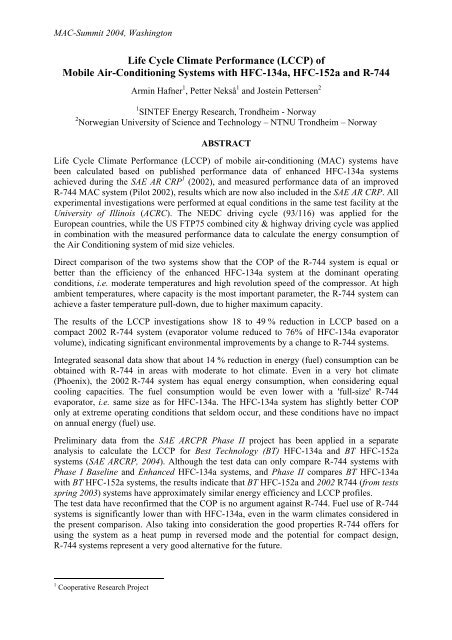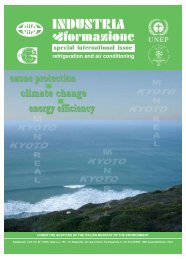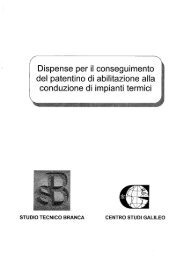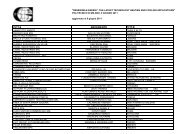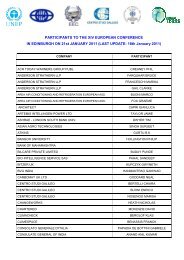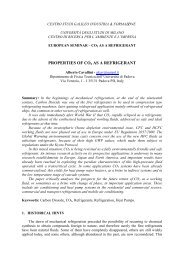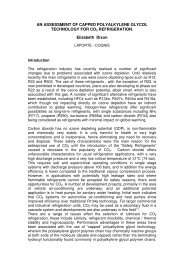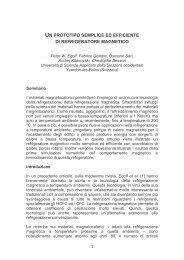Life Cycle Climate Performance (LCCP) of mobile air - Centro Studi ...
Life Cycle Climate Performance (LCCP) of mobile air - Centro Studi ...
Life Cycle Climate Performance (LCCP) of mobile air - Centro Studi ...
You also want an ePaper? Increase the reach of your titles
YUMPU automatically turns print PDFs into web optimized ePapers that Google loves.
MAC-Summit 2004, Washington<br />
<strong>Life</strong> <strong>Cycle</strong> <strong>Climate</strong> <strong>Performance</strong> (<strong>LCCP</strong>) <strong>of</strong><br />
Mobile Air-Conditioning Systems with HFC-134a, HFC-152a and R-744<br />
Armin Hafner 1 , Petter Nekså 1 and Jostein Pettersen 2<br />
1 SINTEF Energy Research, Trondheim - Norway<br />
2 Norwegian University <strong>of</strong> Science and Technology – NTNU Trondheim – Norway<br />
ABSTRACT<br />
<strong>Life</strong> <strong>Cycle</strong> <strong>Climate</strong> <strong>Performance</strong> (<strong>LCCP</strong>) <strong>of</strong> <strong>mobile</strong> <strong>air</strong>-conditioning (MAC) systems have<br />
been calculated based on published performance data <strong>of</strong> enhanced HFC-134a systems<br />
achieved during the SAE AR CRP 1 (2002), and measured performance data <strong>of</strong> an improved<br />
R-744 MAC system (Pilot 2002), results which are now also included in the SAE AR CRP. All<br />
experimental investigations were performed at equal conditions in the same test facility at the<br />
University <strong>of</strong> Illinois (ACRC). The NEDC driving cycle (93/116) was applied for the<br />
European countries, while the US FTP75 combined city & highway driving cycle was applied<br />
in combination with the measured performance data to calculate the energy consumption <strong>of</strong><br />
the Air Conditioning system <strong>of</strong> mid size vehicles.<br />
Direct comparison <strong>of</strong> the two systems show that the COP <strong>of</strong> the R-744 system is equal or<br />
better than the efficiency <strong>of</strong> the enhanced HFC-134a system at the dominant operating<br />
conditions, i.e. moderate temperatures and high revolution speed <strong>of</strong> the compressor. At high<br />
ambient temperatures, where capacity is the most important parameter, the R-744 system can<br />
achieve a faster temperature pull-down, due to higher maximum capacity.<br />
The results <strong>of</strong> the <strong>LCCP</strong> investigations show 18 to 49 % reduction in <strong>LCCP</strong> based on a<br />
compact 2002 R-744 system (evaporator volume reduced to 76% <strong>of</strong> HFC-134a evaporator<br />
volume), indicating significant environmental improvements by a change to R-744 systems.<br />
Integrated seasonal data show that about 14 % reduction in energy (fuel) consumption can be<br />
obtained with R-744 in areas with moderate to hot climate. Even in a very hot climate<br />
(Phoenix), the 2002 R-744 system has equal energy consumption, when considering equal<br />
cooling capacities. The fuel consumption would be even lower with a 'full-size' R-744<br />
evaporator, i.e. same size as for HFC-134a. The HFC-134a system has slightly better COP<br />
only at extreme operating conditions that seldom occur, and these conditions have no impact<br />
on annual energy (fuel) use.<br />
Preliminary data from the SAE ARCPR Phase II project has been applied in a separate<br />
analysis to calculate the <strong>LCCP</strong> for Best Technology (BT) HFC-134a and BT HFC-152a<br />
systems (SAE ARCRP, 2004). Although the test data can only compare R-744 systems with<br />
Phase I Baseline and Enhanced HFC-134a systems, and Phase II compares BT HFC-134a<br />
with BT HFC-152a systems, the results indicate that BT HFC-152a and 2002 R744 (from tests<br />
spring 2003) systems have approximately similar energy efficiency and <strong>LCCP</strong> pr<strong>of</strong>iles.<br />
The test data have reconfirmed that the COP is no argument against R-744. Fuel use <strong>of</strong> R-744<br />
systems is significantly lower than with HFC-134a, even in the warm climates considered in<br />
the present comparison. Also taking into consideration the good properties R-744 <strong>of</strong>fers for<br />
using the system as a heat pump in reversed mode and the potential for compact design,<br />
R-744 systems represent a very good alternative for the future.<br />
1 Cooperative Research Project
MAC-Summit 2004, Washington<br />
INTRODUCTION<br />
HFC-134a from <strong>mobile</strong> <strong>air</strong> conditioning systems is the largest source <strong>of</strong> direct greenhouse gas<br />
emissions within the refrigeration sector. Due to the growth in number <strong>of</strong> systems installed in<br />
the world fleet <strong>of</strong> cars, the emissions are likely to increase also in the future. The high global<br />
warming potential (GWP) <strong>of</strong> HFC-134a (GWP = 1300) has led to the development <strong>of</strong><br />
alternative technology in order to decrease the global warming impact from such systems.<br />
The flammable alternate refrigerant HFC-152a has about 10 % <strong>of</strong> the global warming<br />
potential <strong>of</strong> HFC-134a. Due to its lower GWP it has been suggested as a possible alternative<br />
to the commonly used HFC-134a.<br />
Carbon dioxide, R-744, is a non-flammable and non-toxic refrigerant occurring naturally in<br />
the biosphere, with very favourable characteristics for compact and efficient systems. Carbon<br />
dioxide also <strong>of</strong>fers good heat pump characteristics in reversed mode operation.<br />
Simple theoretical analysis indicates low energy efficiency for R-744 systems compared to<br />
HFC-134a. However, experimental investigations have shown that R-744 systems can be<br />
made with equal or better energy efficiency than HFC systems if the design takes into account<br />
the special characteristics <strong>of</strong> the refrigerant.<br />
PERFORMANCE OF 2002 R-744 MAC SYSTEM<br />
During spring 2003, HRNJAK (2003) conducted measurements on an improved R-744 system<br />
based on components manufactured using 2002 technology. The components <strong>of</strong> the R-744<br />
2002 system were redesigned to be more compact and efficient than earlier prototypes.<br />
Measured performance was improved compared to the previous systems and the main reasons<br />
were:<br />
− More efficient evaporator<br />
− Reduced gascooler temperature approach (more efficient gascooler)<br />
− Improved compressor efficiency (also during part load operation)<br />
Heat exchanger sizes were reduced:<br />
− Evaporator core volume is 76% <strong>of</strong> the enhanced HFC-134a evaporator<br />
(single-row evaporator)<br />
− Gascooler core volume 90% <strong>of</strong> enhanced HFC-134a evaporator<br />
− Gascooler face area 69% <strong>of</strong> enhanced HFC-134a evaporator<br />
Tests were also performed with a 2-row evaporator, twice as large as the single-row<br />
evaporator, but still within the limits <strong>of</strong> the maximum tolerated evaporator depth in the AR<br />
CRP Project. In the following text, these heat exchangers are denoted as: “Small-” and “2-row<br />
evaporator”.<br />
Figure 1 and 2 shows the main COP results as function <strong>of</strong> <strong>air</strong> inlet temperature, at idling<br />
(compressor: 900 rpm) and driving (compressor: 2500 rpm) conditions. Measured data are<br />
compared to reported results for the enhanced HFC-134a system (SAE AR CRP, 2002).
MAC-Summit 2004, Washington<br />
At idling conditions, the R-744 2002 Small system showed better performance compared to<br />
the enhanced HFC-134a system up to 23°C <strong>air</strong> inlet temperature. The 2-row evaporator<br />
system showed improved performance up to 32°C.<br />
At driving conditions, the R-744 2002 Small system showed significantly better performance<br />
than the enhanced HFC-134a system at 15°C and 25°C <strong>air</strong> inlet temperatures, and comparable<br />
at 35°C. The 2-row evaporator-system outperformed the enhanced HFC-134a for all <strong>air</strong> inlet<br />
temperatures by 11% to 39%. Equal evaporator depth as the enhanced HFC-134a would give<br />
a curve in-between the two curves shown.<br />
COP<br />
8<br />
7<br />
6<br />
5<br />
4<br />
3<br />
2<br />
1<br />
0<br />
+7 to +19 %<br />
EnHFC-134a<br />
EnR134a<br />
R-744 2002 2-row 2-slab evaporator<br />
evaporator<br />
R-744 2002 Small<br />
-1 to +8 %<br />
10 15 20 25 30 35 40<br />
Air inlet temperature, o C<br />
- 6 to -10 %<br />
Figure 1: COP data at idling conditions, 5°C <strong>air</strong> from evaporator or equal capacity.<br />
HFC data from SAE AR CRP (2002), R-744 data from HRNJAK (2003)<br />
COP<br />
8<br />
7<br />
6<br />
5<br />
4<br />
3<br />
2<br />
1<br />
0<br />
+28 to +39 %<br />
+21 to +34 %<br />
EnHFC-134a<br />
EnR134a<br />
R-744 2002 2-slab 2-row evaporator<br />
evaporator<br />
R-744 2002 Small<br />
10 15 20 25 30 35 40<br />
Air inlet temperature, o C<br />
-3 to +11%<br />
Figure 2: COP data driving conditions, 5°C <strong>air</strong> from evaporator or equal capacity.<br />
HFC data from SAE AR CRP (2002), R-744 data from HRNJAK (2003)
MAC-Summit 2004, Washington<br />
Figure 3 shows a principal presentation <strong>of</strong> the achieved COP results. Around 90% <strong>of</strong> car<br />
operational time will be at temperatures where the R-744 system has better performance. COP<br />
is important in this temperature range. Only 10% <strong>of</strong> the car usage time will be at high ambient<br />
temperatures where the efficiency <strong>of</strong> the HFC-134a is slightly better. In this temperature<br />
range, capacity is important, for which R-744 performs very well.<br />
COP<br />
R-744<br />
R-134a<br />
More than 90% <strong>of</strong> operation<br />
COP is important<br />
HFC-134a<br />
Condenser/gas cooler <strong>air</strong> inlet temperature<br />
Less than 10% <strong>of</strong> operation<br />
Capacity is important<br />
Figure 3: Typical efficiency at varying condenser/gas cooler <strong>air</strong> inlet temperature<br />
<strong>Performance</strong> investigations for R-744 systems have so far been conducted based on the test<br />
data for HFC-134a systems, demanding equal cooling capacity. However, the maximum<br />
cooling capacity <strong>of</strong> the R-744 system is significantly larger. Figure 4 shows measured<br />
maximum cooling capacities for the CO2 system at 35°C ambient temperature. Both at idling<br />
and driving conditions the 2002 R-744 Small system has 15% higher capacity. This will give<br />
a faster pull down at high ambient temperatures. If equal cooling capacity is required, the<br />
R-744 system will operate at part-load, where the efficiency <strong>of</strong> the compressor is slightly<br />
lower, compared to a system with smaller compressor (reduced displacement).<br />
Evaporator Capacity [kW]<br />
10<br />
9<br />
8<br />
7<br />
6<br />
5<br />
4<br />
3<br />
2<br />
1<br />
0<br />
2002 R744 Small<br />
+15%<br />
+11%<br />
En HFC-134a R134a<br />
+15%<br />
900 rpm 1500 rpm 2500 rpm<br />
Figure 4: Maximum evaporator capacity for 35°C ambient condition<br />
All experimental results show that the 2002 R-744 system has significant improvements in<br />
COP and <strong>of</strong>fers better capacity compared to the enhanced HFC-134a system at the dominant<br />
conditions, i.e. moderate temperatures and higher compressor rpm.
MAC-Summit 2004, Washington<br />
BASES FOR LIFE CYCLE CLIMATE PERFORMANCE (<strong>LCCP</strong>) CALCULASSIONS<br />
Simplified <strong>LCCP</strong> calculations have been carried out based on the following assumptions:<br />
• Compressor power from<br />
o SAE AR CRP data for enhanced HFC-134a (SAE ARCRP, 2002)<br />
o 2002 R-744 Pilot Project data from HRNJAK (2003) – Small system (Single-row<br />
evaporator)<br />
o SAE ARCPR Phase II data for HFC-134a and HFC-152a (SAE ARCRP, 2004)<br />
• 25% <strong>of</strong> the idle operation time at elevated <strong>air</strong> inlet temperatures (+15K) to the condenser/<br />
gascooler.<br />
• NEDC driving cycle (93/116) applied for the European countries, and US FTP75<br />
combined city & highway driving cycle, applied for the North American locations.<br />
• AC on distribution based on DUTHIE et al. (2002).<br />
• Yearly driving distance: Germany & Greece (13.321 km), Spain (10.738) from<br />
HOVLAND et al. (2003). US locations 22.000 km<br />
• R-744 system 1.6 kg heavier than the enhanced HFC-134a systems, even though current<br />
prototypes show less weight difference than this. The assumed total weight <strong>of</strong> the<br />
HFC-152a system was in the same range as for the HFC-134a system.<br />
o Fuel use due to transportation <strong>of</strong> AC system was taken from (AFEAS,<br />
1991).Conversion <strong>of</strong> fuel use to CO2 emissions: 2.32 kg CO2/liter <strong>of</strong> gasoline<br />
(AFEAS, 1994).<br />
• Direct HFC emission data per vehicle based on:<br />
o Controlled losses (SCHWARTZ & HARNISCH, 2003) <strong>of</strong> 53 g/yr,<br />
plus estimate for uncontrolled losses from Öko-Recherche <strong>of</strong> 16 g/yr, plus<br />
estimate for service losses 10 g/yr: total 80 g/yr (not applied in this analysis)<br />
o Achievable total controlled losses <strong>of</strong> 35 g/yr suggested by FERNQVIST (2003),<br />
plus uncontrolled and service losses: total 60 g/yr (used in this analysis)<br />
o End-<strong>of</strong>-life recovery 80%<br />
• CO2 emission associated with energy input (kg CO2/kWh) is 0.243 (AFEAS, 1994)<br />
• Engine efficiency: 27%. (SAND et al., 1997)<br />
• Production <strong>of</strong> HFC-134a gives/causes an emission <strong>of</strong> 77 kg CO2-equivalents per kg HFC<br />
(CAMPBELL & MCCULLOCH, 1998), equal emissions were assumed for the production <strong>of</strong><br />
HFC-152a.Vehicle life was assumed to 13 years, while 2 lifetime services are carried out<br />
during this time.
MAC-Summit 2004, Washington<br />
Figure 5 shows the temperature bin data for selected cities in USA, Japan and selected<br />
countries in Europe. Two extreme climates shown are Miami and Phoenix. Miami has a warm<br />
climate most <strong>of</strong> the year, but temperatures are hardly ever above 35°C. Phoenix has a very<br />
warm climate in the summer, and is the only city with significant number <strong>of</strong> hours with<br />
temperatures above 35°C. Chicago represents the climate <strong>of</strong> the Midwest. Taking all the<br />
presented locations into account, the figure clearly reveals that temperatures above 35°C<br />
hardly ever occur.<br />
USA Midwest, Chicago<br />
USA Sourtheast, Miami<br />
USA Southwest, Phoenix<br />
Japan, Kadena<br />
Japan, Misawa<br />
United Kingdom<br />
Germany<br />
Greece<br />
Italy<br />
Spain<br />
35o 35 C oC -30 -20 -10 0 10 20 30 40 50<br />
Ambient temperature ( o C)<br />
Figure 5: Temperature bin data (SAND et al. 1997)<br />
Germany has the highest number <strong>of</strong> registered cars in Europe (HOVLAND et al. (2003)), while<br />
Spain and Greece are representatives for the warmest climates in Europe.<br />
The <strong>LCCP</strong> calculations are conducted for six selected locations, three cities in the USA, and<br />
three locations in Europe, Germany, Greece and Spain, respectively. The US FTP75<br />
combined city & highway driving cycle was applied for North America, while the NEDC<br />
driving cycle (93/116) was applied for the European countries, as shown in Figure 6.<br />
Vehicle velocity [km/h] .<br />
120<br />
100<br />
80<br />
60<br />
40<br />
20<br />
FTP 75<br />
City <strong>Cycle</strong> Highway <strong>Cycle</strong><br />
0<br />
0 500 1000 1500 2000 2500<br />
Time [s]<br />
Vehicle velocity [km/h]<br />
120<br />
100<br />
80<br />
60<br />
40<br />
20<br />
Urban <strong>Cycle</strong><br />
4500<br />
4000<br />
3500<br />
3000<br />
2500<br />
2000<br />
1500<br />
1000<br />
500<br />
0<br />
N NEFZ EDCC<br />
Hours<br />
Extra Urban <strong>Cycle</strong><br />
0<br />
0 250 500 750 1000<br />
Time [s]<br />
Figure 6: US FTP75 combined city & highway driving cycle & NEDC driving cycle<br />
(93/116) (WERTENBACH 2004)
MAC-Summit 2004, Washington<br />
AC usage pr<strong>of</strong>iles are used as basis in the <strong>LCCP</strong> calculations. In the calculations, Europe and<br />
the USA have different AC-usage percentile pr<strong>of</strong>iles as suggested by DUTHIE et al. (2003) and<br />
also applied by WERTENBACH (2004). The driving cycle data (rpm <strong>of</strong> the compressor) in<br />
combination with the measured performance data, as referenced earlier, are applied to calculate the<br />
energy consumption <strong>of</strong> the AC systems for a typical mid size vehicle. Cooling demand as a function<br />
<strong>of</strong> the ambient temperature, as suggested by WERTENBACH (2004).<br />
<strong>LCCP</strong> ANALYSIS: ENHANCED HFC-134a VERSUS 2002 R-744<br />
Figure 7 and 8 shows the <strong>LCCP</strong> comparison for enhanced HFC-134a and 2002 R-744 Small<br />
system at 60g leakage <strong>of</strong> HFC-134a per year. The HFC-134a and R-744 systems have three<br />
contributions to the total <strong>LCCP</strong> number indicated as: “Indirect” from AC usage, “Mass” from<br />
increased vehicle mass and “Direct” from the production <strong>of</strong> HFC-134a, emission from vehicle<br />
AC circuit, and from reclaiming <strong>of</strong> HFC at vehicle end <strong>of</strong> life. The “Direct -emission” <strong>of</strong> R-<br />
744 system is about 1 and cannot be observed in the figures.<br />
As can be seen from Figure 7, the total <strong>LCCP</strong> numbers for the different US locations are<br />
between 18 and 39 % lower for the R-744 system. This may represents a significant<br />
contribution to reduced Green House Gas (GHG) emissions in North America.<br />
The fuel consumption is reduced for the R-744 system in Miami (-3%) and in Chicago (-5%).<br />
Equal fuel consumption is estimated in the hot climate conditions <strong>of</strong> Phoenix.<br />
Figure 8 shows the total <strong>LCCP</strong> numbers for the different European countries. For Germany a<br />
up to 49% reduction in <strong>LCCP</strong> can be obtained with a R-744 system. In Spain the reduction<br />
will be 39%, while a 31% lower <strong>LCCP</strong> can be achieved in Greece, by applying a R-744<br />
system. . This represents a significant contribution to reduced GHG emissions in Europe.<br />
The fuel consumption <strong>of</strong> the AC-system can be reduced by 13 % in Germany and Spain,<br />
while a 14 % reduction can be achieved in Greece.<br />
All calculations for R-744 systems above are based on measurements performed with the<br />
small evaporator, which has 76% <strong>of</strong> the HFC-134a evaporator core volume. Measurements<br />
with the R-744 2-row evaporator (153 % <strong>of</strong> HFC-134a evaporator core volume), showed<br />
significantly improved performance. This indicates that energy use for R-744 systems would<br />
be even lower with equally sized evaporators.
MAC-Summit 2004, Washington<br />
E n HFC134a<br />
R744<br />
2002<br />
E n HFC134a<br />
R744<br />
2002<br />
E n HFC134a<br />
R744 2002<br />
En HFC134a<br />
R744<br />
2002<br />
En HFC134a<br />
R744<br />
2002<br />
En HFC134a<br />
R744 2002<br />
Indirect Mass Direct<br />
0 1000 2000 3000 4000 5000 6000 7000 8000<br />
Indirect Mass Direct<br />
-49%<br />
-39%<br />
Germany<br />
-39%<br />
Chicago<br />
<strong>LCCP</strong><br />
0 1000 2000 3000 4000 5000 6000 7000 8000<br />
<strong>LCCP</strong><br />
US FTP75<br />
Combined City & Highway driving <strong>Cycle</strong><br />
En HFC-134a R744 2002<br />
System Mass: 14.4 kg 16 kg<br />
Direct Leakage: 60 g/yr 50 g/yr<br />
Indirect: SAE CRP UIUC<br />
NEDC NEFZ<br />
Driving <strong>Cycle</strong> European Union (93/116)<br />
En HFC-134a R744 2002<br />
System Mass: 14.4 kg 16 kg<br />
Direct Leakage: 60 g/yr 50 g/yr<br />
Indirect: SAE CRP UIUC<br />
Spain<br />
-31%<br />
-20%<br />
-18%<br />
Miami<br />
Phoenix<br />
Figure 7: <strong>LCCP</strong> comparison <strong>of</strong> Enhanced HFC-134a system and R-744 (2002)<br />
system, based on US FTP75 driving cycle. HFC-134a leakage <strong>of</strong> 60 g/year.<br />
Greece (Athen)<br />
Figure 8: <strong>LCCP</strong> comparison <strong>of</strong> Enhanced HFC-134a system and R-744 (2002)<br />
system, based on NEDC driving cycle. HFC-134a leakage <strong>of</strong> 60 g/year.
MAC-Summit 2004, Washington<br />
<strong>LCCP</strong> ANALYSIS HFC-134a VERSUS HFC-152a:<br />
System COP data measured during the Phase II SAE ARCRP program are applied for the<br />
calculation <strong>of</strong> the required energy <strong>of</strong> the HFC AC systems. It must be emphasised that these<br />
data are only available in a preliminary report, so far. Thus, changes may be made before the<br />
final report is available.<br />
Figure 9 and 10 shows the <strong>LCCP</strong> comparison for HFC-134a (2004) and HFC-152a system at<br />
60g leakage <strong>of</strong> HFC per year. “Direct” contribution to the total <strong>LCCP</strong> from the production <strong>of</strong><br />
HFC-134a, emission from vehicle AC circuit, and from reclaiming <strong>of</strong> HFC at vehicle end <strong>of</strong><br />
life are around 1230 [eq. kg CO2]. The “Direct -emission” <strong>of</strong> a HFC-152a system is about<br />
200 [eq. kg CO2].<br />
As can be seen from Figure 9, the total <strong>LCCP</strong> numbers for the different US locations are<br />
between 18 and 31 % lower for the HFC-152a system. The largest reduction can be obtained<br />
in areas with more moderate climates (like in the Midwest), since the total <strong>LCCP</strong> is lower in<br />
these areas; the reduction <strong>of</strong> the direct contribution has a larger impact.<br />
The fuel consumption is reduced for the HFC-152a system in Miami and in Chicago by about<br />
3 %. The fuel consumption <strong>of</strong> AC systems, operating in hot climate conditions like in the<br />
Phoenix, are reduced by about 5 %, when applying a HFC-152a system.<br />
Figure 10 shows the total <strong>LCCP</strong> numbers for the different European countries. For Germany a<br />
up to 40% reduction in <strong>LCCP</strong> can be obtained with a HFC-R152a system. In Spain the<br />
reduction will be 31%, while a 22% lower <strong>LCCP</strong> can be achieved in Greece when applying a<br />
HFC-152a system.<br />
The fuel consumption <strong>of</strong> the AC-system can be reduced by 3 % in Greece and Spain, while a<br />
4 % reduction can be achieved in Germany.<br />
Direct comparison to the Phase I SAE ARCRP data is not possible.
MAC-Summit 2004, Washington<br />
HFC 152a<br />
HFC 134a<br />
HFC 152a<br />
HFC 134a<br />
HFC152a<br />
HFC 134a<br />
Indirect Mass Direct<br />
-31%<br />
Chicago<br />
0 1000 2000 3000 4000 5000 6000 7000 8000<br />
<strong>LCCP</strong><br />
US FTP75<br />
Combined City & Highway driving <strong>Cycle</strong><br />
HFC-134a / HFC-152a<br />
System Mass: 14.4 kg 14.4 kg<br />
Direct Leakage: 60 g/yr 60 g/yr<br />
Indirect: SAE ARCRP II<br />
-17%<br />
-18%<br />
Miami<br />
Phoenix<br />
Figure 9: <strong>LCCP</strong> comparison <strong>of</strong> HFC-152a and HFC-134a systems, based on US FTP75<br />
driving cycle. HFC leakage <strong>of</strong> 60 g/year. System COP data, from SAE ARCRP II (2004).<br />
HFC152a<br />
HFC 134a<br />
HFC152a<br />
HFC 134a<br />
HFC152a<br />
HFC 134a<br />
Indirect Mass Direct<br />
-40%<br />
Germany<br />
-31%<br />
0 1000 2000 3000 4000 5000 6000 7000 8000<br />
<strong>LCCP</strong><br />
Spain<br />
NEDC<br />
Driving <strong>Cycle</strong> European Union (93/116)<br />
HFC-134a / HFC-152a<br />
System Mass: 14.4 kg 14.4 kg<br />
Direct Leakage: 60 g/yr 60 g/yr<br />
Indirect: SAE ARCRP II<br />
-22%<br />
Greece (Athen)<br />
Figure 10: <strong>LCCP</strong> comparison <strong>of</strong> HFC-152a and HFC-134a systems, based on NEDC<br />
driving cycle. HFC leakage <strong>of</strong> 60 g/year. System COP data, from SAE ARCRP II (2004).
MAC-Summit 2004, Washington<br />
DISCUSSION / COMMENTS<br />
A few comments can be made to the test program and the choice <strong>of</strong> components in the two<br />
systems that are the basis for the first <strong>LCCP</strong> comparison (Enhanced HFC-134a and 2002<br />
R-744):<br />
• Very good baseline in SAE Enhanced HFC-134a system:<br />
o Extremely high COP<br />
o Large heat exchanger sizes<br />
o Condenser with high <strong>air</strong> flow rate and low refrigerant-side pressure drop<br />
o Large difference to common AC systems in production today, probably<br />
giving large challenges when introducing such an enhanced HFC-134a<br />
system into vehicles, due to packaging problems.<br />
• Limited focus <strong>of</strong> test program:<br />
o Focus on very high ambient temperature conditions<br />
o Focus on COP data at high ambient, instead <strong>of</strong> seasonal comparison <strong>of</strong><br />
energy use<br />
o No test points were measured at high compressor revolution speeds<br />
(above 2500 rpm)<br />
• Unfortunate R-744 compressor sizing:<br />
o Large compressor displacement giving part-load losses<br />
Only low leakage rates (60 g/year) have been applied in the <strong>LCCP</strong> analysis. These leakage<br />
rates are believed to be obtainable in vehicles <strong>of</strong> the future, if enough effort is given to this<br />
issue.<br />
During idling, the <strong>air</strong> inlet temperature to the condenser/gascooler is sometimes elevated for<br />
some car models, due to recirculation <strong>of</strong> hot <strong>air</strong> from heat rejecting components. This effect is<br />
strongly dependent on the design <strong>of</strong> the engine compartment, at the same time; this effect<br />
occurs manly if the wind comes from the backside <strong>of</strong> the car, i.e. tailwind situations. The<br />
temperature distribution <strong>of</strong> the recirculated <strong>air</strong>flow is in addition not homogeneous. The<br />
efficiency <strong>of</strong> different AC-systems reacts differently to inhomogeneous <strong>air</strong> inlet temperatures.<br />
Therefore, a conservative assumption <strong>of</strong> 25% occurrence <strong>of</strong> increased <strong>air</strong> inlet temperature<br />
(+ 15 K) during idling was applied in this analysis.<br />
The second analysis showed the possible <strong>LCCP</strong> reduction potential <strong>of</strong> replacing the common<br />
HFC-134a by a so-called drop in solution, HFC-152a. The energy consumption <strong>of</strong> the<br />
HFC-152a system did not show an equal improvement at different operating conditions<br />
compared to the HFC-134a system. The <strong>LCCP</strong> analysis showed a energy saving potential <strong>of</strong><br />
the AC system from 3 to 5 %.<br />
Preliminary data from the SAE ARCPR Phase II project has been applied in the second<br />
analysis to calculate the <strong>LCCP</strong> for HFC-134a and HFC-152a systems (SAE ARCRP, 2004).<br />
These data are not directly comparable to the SAE ARCPR Phase I data, however, a<br />
comparable <strong>LCCP</strong> reduction on the Phase I HFC-134a data would still give <strong>LCCP</strong> values for<br />
R-744, which were lower or at the same level<br />
Heat pump operation was not included in this <strong>LCCP</strong> analysis. As high-efficiency car engines<br />
with less waste heat are developed, extra heating <strong>of</strong> the passenger compartment is needed in<br />
the cold season. Reversible R-744 systems represent a high-efficiency auxiliary heating
MAC-Summit 2004, Washington<br />
device. Such reversible R-744 systems can give high <strong>air</strong> delivery temperature, which results in<br />
rapid heating <strong>of</strong> the passenger compartment and rapid defogging or defrosting <strong>of</strong> windows, as<br />
presented by FRÖHLING et al.(2002), MAGER et al. (2002) & MEMORY et al. (2003). An <strong>LCCP</strong><br />
analysis <strong>of</strong> different auxiliary heating systems has to be conducted. Reversible R-744 systems<br />
have clear advantages.<br />
CONCLUSIONS<br />
• The test data have reconfirmed that COP is no argument against R-744 systems.<br />
• Fuel use <strong>of</strong> 2002 R-744 system is significantly lower than with Enhanced<br />
HFC-134a (up to 14 % in Europe), even in the warm climates (Phoenix) the total<br />
energy consumptions will be at the same level.<br />
• <strong>LCCP</strong> <strong>of</strong> the 2002 R-744 system is improved by 18 – 49 % compared to<br />
Enhanced HFC-134a system.<br />
• The Best Technology (BT) HFC-152a system uses 3 to 5 % less energy (fuel) than<br />
the BT HFC-134a system.<br />
• The <strong>LCCP</strong> <strong>of</strong> the BT HFC-152a system is improved by up to 40 % compared to<br />
an BT HFC-134a system.<br />
The test data have reconfirmed that the COP is no argument against R-744. Fuel use <strong>of</strong> R-744<br />
systems is significantly lower than with HFC-134a, even in the warm climates considered in<br />
the present comparison. Also taking into consideration the good properties R-744 <strong>of</strong>fers for<br />
using the system as a heat pump in reversed mode and the potential for compact design,<br />
R-744 systems represent a very good alternative for the future.<br />
ACKNOWLEDGEMENT<br />
The authors would like to thank for input and support given by the following companies:<br />
Audi, BMW, DaimlerChrysler, Denso, LuK, Modine, Obrist Engineering,<br />
Shecco Technologies, U <strong>of</strong> Illinois and Visteon.
MAC-Summit 2004, Washington<br />
BIBLIOGRAPHY<br />
AFEAS 1991. Energy and Global Warming Impacts <strong>of</strong> CFC Alternative Technologies, December<br />
1991<br />
AFEAS 1994. Energy and Global Warming Impacts <strong>of</strong> Not-In-Kind and Next Generation CFC and<br />
HCFC Alternatives, December 1994<br />
HOVLAND, V. & FARRINGTON, R. 2003. Fuel Consumption and Associated CO2 Emissions due to<br />
MACs. Presented at MAC Summit, Brussels, Belgium, February 10-11 2003<br />
FERNQVIST, H., 2003. Fuel efficient leak tight HFC-134a systems through design and quality<br />
improvements, presented at MAC Summit, Brussels, Belgium, February 10-11 2003<br />
FRÖHLING, J. & WIESCHOLLEK, F. 2002. Heat Pump with CO2 – <strong>Performance</strong> and Switching,<br />
presented at the VDA Alternate Refrigerant Wintermeeting 2002, Saalfelden, Austria, January<br />
30.<br />
HRNJAK, P., 2003. Design and performance <strong>of</strong> improved R-744 System Based on 2002 technology,<br />
presented at SAE Automotive Alternate Refrigerant Systems Symposium, Scottsdale, Arizona,<br />
July 15-17 2003.<br />
CAMPBELL N.J. & A. MCCULLOCH, 1998. The <strong>Climate</strong> Change Implications <strong>of</strong> Manufacturing<br />
Refrigerants --- A Calculation <strong>of</strong> Production Energy Contents <strong>of</strong> Some Common Refrigerants,<br />
Transactions <strong>of</strong> the Institution <strong>of</strong> Chemical Engineers, Vol. 76, Part B, August 1998.<br />
DUTHIE, G.S., HARTE, S. & JAJASHEELA, 2002. European Average Mobile A/C Customer Usage<br />
Model, Visteon <strong>Climate</strong> Control Group. presented at SAE Automotive Alternate Refrigerant<br />
Systems Symposium, Scottsdale, Arizona, July 2002.<br />
MAGER, R., HAMMAER, H. & WERTENBACH, J. 2002. Comparative study <strong>of</strong> AC- and HP-systems<br />
using the refrigerants R134a and R744, presented at the VDA Alternate Refrigerant<br />
Wintermeeting 2002, Saalfelden, Austria, January 30.<br />
MEMORY, S., & VETTER, F., 2003. Automotive AC/HP Systems Using R-744 (CO2), Sixth Vehicle<br />
Thermal Management Systems Conference (VTMS6), Brighton, UK, May 18-21.<br />
SAE ARCRP, 2002. Alternate Refrigerant Cooperative Research Project, Update Report November<br />
2002 http://www.sae.org/technicalcommittees/nov-2002-overview.pdf<br />
SAE ARCRP, 2004. Alternate Refrigerant Cooperative Research Project Phase II, Interim Report –<br />
R152a and R134a. March 2004.<br />
SAND, J. R., FISCHER, S. K., & BAXTER, V. D., 1997. Energy and global warming impacts <strong>of</strong> HFC<br />
refrigerants and emerging technologies, AFEAS/DOE report<br />
SCHWARTZ, W., & HARNISCH, J., 2003. Establishing the leakage rates <strong>of</strong> <strong>mobile</strong> <strong>air</strong> conditioners, final<br />
report (B4-3040/2002/337136/MAR/C1) prepared by Öko-Recherche and Ec<strong>of</strong>ys for the<br />
European Commission (DG Environment), 17 April 2003<br />
WERTENBACH, J. 2002. Energy Analysis <strong>of</strong> Refrigerant <strong>Cycle</strong>s, presented at the VDA Alternate<br />
Refrigerant Wintermeeting 2004, Saalfelden, Austria, February 18.


